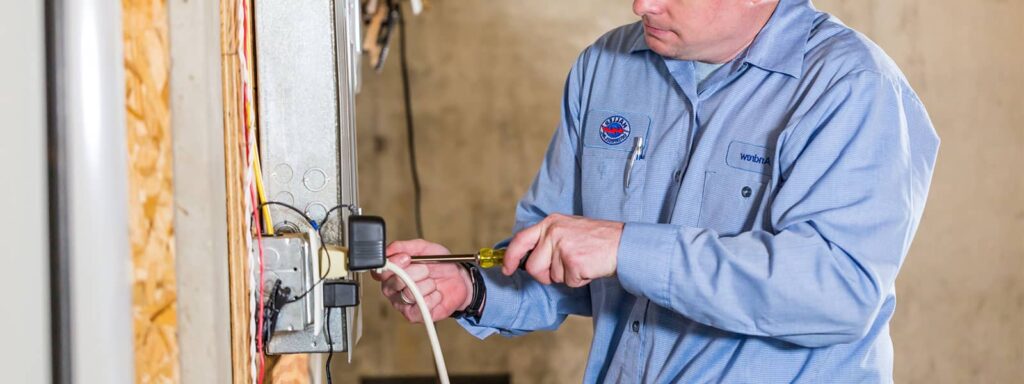As spring winds down and summer gears up, it’s time to consider your home cooling situation. You don’t want to get caught in the middle of the heat and realize your air conditioner looks a little worse for wear.
Even as summer closes in, you never know when a cold snap might return with a vengeance. As many air conditioners double as heating units, it’s always wise to assess your thermal protection against the elements. Regardless of season, your unit needs to efficiently handle the circumstance.
The question then arises: Which air conditioning option offers the best result for the lowest price?
A mini split system offers an optimal combination of quality and affordability. The mini split boasts many advantages. The rewards make it a great choice compared to a central air conditioning system for many prospective buyers. The perks of owning a mini split are hard to deny.
The benefits range from areas such as price, effectiveness, ease of maintenance, installation, versatility, cleanliness, health safety, and environmental considerations.
What Is a Mini Split?
A mini split is an air conditioner and heating unit, and it distinguishes itself from other air conditioners/heaters in several ways. Unlike central air systems, mini splits don’t employ ducts or ventilation. They function in a much simpler, more integrated and self-contained manner. They bear closer comparison to standard split systems as they function extremely similarly, except they’re smaller.
Split systems split their components between the interior and exterior of your house. The indoor part represents the more iconic aspect of a mini split. You’ve likely seen them before. They’re large, stout, white, horizontal machines typically placed above windows or higher up on walls that share a side with the exterior of your home.
Mini splits always offer air conditioning and often double as heating units. When they come equipped with heating ability, they’re called heat pumps. Their position high up on walls enables the treated air, either cold or hot, to flow naturally into your home.
Not all mini splits sit high on the wall. Your preference for position determines their eventual location. For instance, many mini split owners prefer ceiling-mounted units. The versatility of the mini split lets you decide which option best suits your needs.
How Do Mini Splits Work?
A mini split utilizes two main components. As we described, the interior aspect is the white air handler, which is mounted on a wall. The exterior element, or condenser, sits on the ground, outside your house. The condenser connects to the air handler through a refrigerant line.
The process begins with the condenser. Inside it, the compressor applies intense pressure to refrigerant gas. As the gas gains pressure, it naturally draws heat from the surrounding air. This process also transforms the gas into liquid refrigerant, when is then fed through the line to the indoor component.
Once the heat-sucking liquid reaches the air handler, it snakes its way through the evaporator coil inside. This cools the surrounding air. A fan simply cycles air through the evaporator coil, which draws out the heat and blows the cool air outward into your room.
Some mini splits also function as heaters. They accomplish this task by inverting the cooling process. The refrigerant undergoes a treatment in the condenser coil, located in the condenser, which results in the refrigerant producing heat. The heated refrigerant passes into the indoor unit’s evaporator coil. The blower cycles the interior air over the coils warming the air.
This process allows your mini split to work seamlessly. This technique isn’t exclusive to mini splits. Central air systems employ the same tactics of allocating certain tasks to indoor and outdoor parts.
How Do Mini Splits Differ From Central Air Systems?
The main difference between these two systems centers on their air distribution method. Central air relies on a central unit, usually in the basement or a closet, which disseminates the treated air throughout the house using ducts and vents.
Despite this aspect, the two systems fundamentally treat air using the same technique. Both central air systems also use indoor and outdoor components. For central air, once the air undergoes, it enters the network of ducts and is piped to individual rooms in a house. For mini splits, the treated air simply is blown out, entering the room in which the system is located.
Why Should You Use Mini Splits in Your Home?
A major consideration when choosing to invest in a mini split versus central air is price. Mini splits offer a cost effective and quicker option. A central air system includes many parts. The combined price tag of all these elements adds up to a substantial amount. A central air system requires a central unit, the outdoor condenser, an extensive duct system, and vents. Meanwhile, a mini split only needs the two components of the indoor air handler and exterior condenser.
On top of all the expensive parts, the installation cost for central air costs more than mini splits. It makes sense when you consider all the work required to install a house-wide system. It takes a significant amount of time to install all the ducts and cut holes for ventilation locations. With the cost of labor included, a new central air system will likely cost thousands of dollars. However, it can still be the best option for some consumers.
Mini splits utilize only two main parts, which results in less money spent on the apparatus itself. With less time required to properly install a mini split, you pay less for installation costs. Central air simply can’t compete in regard to cost considerations.
Why Can’t You Install Central Air/Vents in an Older Home?
With older homes, certain factors make it difficult to install central air. The builders of older homes didn’t consider the possibility of central air systems in the future. Older homes often don’t possess the interior wall space needed to support a network of air ducts and vents. In addition, damage caused by installation occasionally undermines the home’s structural integrity. If it’s possible to perform the installation without irrevocably harming the house, it will still cost you an untold sum of money.
In addition, your circuit breaker requires enough space to add the additional breakers to support a central air system. Older circuit boards often don’t meet the necessary size requirement for adding extra breakers, and require upgrades. It can cost well over one thousand dollars, plus the labor costs of an electrician.
Retrofitting your home with central air carries many disclaimers. In addition to the renovations, older homes protected by historical preservation may be unable to undergo such large-scale changes. Review the implications of installing such a system in an older home before deciding to invest the money.
Highly Flexible
While central air requires conditions to present themselves perfectly, mini splits are easy going. They certainly offer a lower maintenance alternative to central air. Their natural flexibility extends to how they cool or heat an easily defined area.
Essentially, mini splits cool or heat a single room. This affords several advantages. You easily decide how large an area you want affected by opening or closing doors. The mini split circulates all the air in its given environment so you merely expand its area of influence.
Meanwhile, if you only want one room affected, close the door and enjoy. This tactic utilizes only the necessary output of a mini split. You’re not endlessly heating or cooling empty rooms. The majority of your time at home is usually spent in one or two areas. Why pay to pointlessly air condition or heat an entire house?
The versatility of a mini split lets you decide which zones you want affected, saving you money and adding to the customization of your mini split experience.
Improvement of Air Quality
Mini splits offer better air quality than central air. Mini splits operate as a self-contained unit, so you never worry about unseen contaminants affecting your air quality. Central air relies on a largely unseen, and difficult to clean, network of ducts and vents.
Ducts and vents accumulate dust, dirt and grime. The task of cleaning your ducts requires an extensive time-consuming effort. The large number of parts to clean requires a large effort to address. From the return air registers to blower compartments, each part requires cleaning.
The hardest part to clean in a central air system is the ducts. You need to manually unscrew the ducts’ support screws, which attach them to their affixed surface. After you disassemble the ducts, you need to physically reach inside and wipe out every square inch of their interior surface before returning them to their previous position and screwing them securely back into place. All told, this constitutes a giant, filthy hassle. Mini splits offer an effortless alternative to this messy task.
If central air ducts are improperly cleaned, they produce increasingly dusty and dirty air. The dirty air carries tiny unseen particles that will cover every surface of your house and require constant cleaning to remedy. Most importantly, dirty air represents a health hazard.
Breathing unclean air can provoke allergy symptoms like coughing, sneezing, sore throat and nasal congestion. It’s easy to attribute such symptoms to seasonal changes, but your central air system could be causing the reaction. Over longer periods of exposure to dirty air, health conditions may deteriorate and lead to irritations or infections.
Mini split offers an easier-to-clean and more sanitary alternative. Mini split filters are easier to access and clean, and they function using multi-stage filtration. After air passes through one filter, it passes through another, and then another. This system effectively removes any lingering impurities. Only perfectly clean air emerges from a mini split’s multiple filtration system.
With a cleaner product and less effort required to clean than central air, mini splits represent the healthier, simpler alternative.
Ductless Cooling Allows for Greater Energy Efficiency
Mini splits use less electricity than central air. With that established, several positive repercussions result from your decreased energy consumption. For instance, a smaller power bill. With less money spent on electricity with a mini split, you save money by rejecting central air. A mini split cools and heats your home in the most economical way possible. There’s no wastage with a mini split. Since a mini split affects only the areas you want heated or cooled, you never use electricity to cool or heat unwanted spaces, resulting in an optimal use of power.
With decreased electrical consumption comes the added environmental bonus. Your lower power usage saves you money, and it saves the environment. Many places in the United States rely on fossil fuels to produce electricity. By limiting your energy use, you lessen the stress placed on energy facilities. As a mini split offers the best way to limit your energy impact, it also represents the best choice for anyone hoping to help the environment.
Contact Haller for Mini Split Consultation & Installation
As you see, the mini split boasts a long list of advantages. With virtually every base covered, they represent the best option for your home air conditioning and heating needs. They beat central air in every major category: price, installation, customization, versatility, cleanliness, ease of maintaining, and environmental impact. Unfortunately for central air, the competition seems a little one sided.
At Haller, we consider mini splits the best option for almost every customer. We’ve been in the business of providing expert advice and service to our customers in central PA and beyond for over 30 years.
If you have any questions about how we best to install a mini split in your home, we’ll tell you the best way. Contact us for a free mini split consultation.




